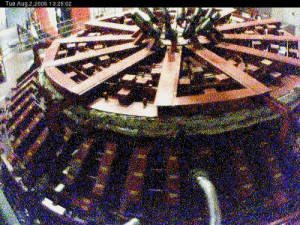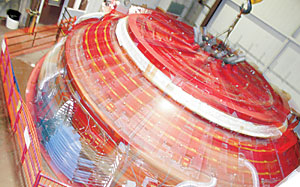 |
|
Courtesy of the Steward Observatory Mirror Lab
|
The first of seven 8.4-meter diameter mirrors was cast in The Steward Observatory Mirror Laboratory last week. The mirrors, when finished, will be used for what will become part of the world's most powerful telescope, the Giant Magellan Telescope.
|
|
|
By Evan Pellegrino
Arizona Daily Wildcat
Wednesday, August 3, 2005
Print this
Humankind's aspiration for exploring the infinite world of space has led to a new breed of larger telescope, currently under construction right on campus.
The UA's Steward Observatory Mirror Laboratory, located under the east side of Arizona Stadium, is casting the first of seven 8.4-meter (in diameter) mirrors that will be used for what will become part of the world's most powerful telescope, the Giant Magellan Telescope.
The images seen through the telescope will be "10 times sharper" than images from the Hubble Space Telescope, said GMT project manager assistant director Matt Johns of Carnegie Observatory, a GMT partner.
Considering the awe-inspiring photographs taken by Hubble, if the GMT turns out to be as good as predicted, it will revolutionize earth-based space exploration.
GMT's concept is a combination of ideas and experiences in optical design, said UA professor of astronomy and UA Steward Observatory astronomer Dr. Neville J. Wood.
Since 1980, Woolf has been involved with the progression of concepts, models, and "desires" that have lead to GMT's design.
"The current plan is to have the last mirror finished sometime in 2014 and the telescope (completed) in 2015 or 2016," said Steve Miller, manager of Steward Observatory Mirror Laboratory.
The first mirror is currently being spun cast at the Steward Lab in a giant rotating oven. The spinning of the oven, in addition to the extremely high temperatures, gives the mirror a parabolic, or concave, shape, which makes the mirror more effective at collecting light than a flat mirror.
Casting of the first mirror began July 17, and peak temperatures of over 2,000 degrees were reached less than a week later on July 23.
The mirror will continue to spin and gradually cool over the next few months with completion of the casting for the first mirror scheduled for Oct. 12.
According to the Steward Observatory, 21 tons of glass was used to produce the 8.4-meter mirror.
After casting, the mirror will be removed from the oven, cleaned, and polished to acute dimensions.
GMT will be a multi-mirrored telescope, a concept that dates back to the 1930s. In addition to being multi-mirrored, the telescope will incorporate a "tile" formation design, said Woolf.
With six angled mirrors surrounding one center mirror, GMT's body will have a "bowl shape."
According to Johns, the expectations of GMT are based on the progress and achievements already made in the science of optics. Other telescopes are, "part of the way there," said Johns, but GMT will reach new frontiers of telescope achievement.
Other telescopes have picked up faint images of space attractions, but they lack the ability to collect the light necessary for higher-resolution images.
The seven mirrors of GMT, about as large as telescope mirrors can presently be made, will be able to absorb more light then any current telescope, and will provide scientists with sharper images and sharper answers to questions posed by space.
The telescope's location, set for northern Chile, has been carefully selected by the Carnegie Institution of Washington, said Woolf.
A telescope has a great deal of dependence on its location for the clarity of the images the telescope captures, explained Woolf.
If too much hot and cold air in the atmosphere mix at the site, Woolf said, the telescope would intensify the blurring effect of the air and it would be like "looking through the air above the campfire."
 |
|
JACOB KONST/Arizona Summer Wildcat
|
|
According to Woolf, current telescopes at the location in Chile are providing "exquisite and beautiful images," proving GMT has a good home upon completion.
A press release from the GMT team states that the "focused scientific goals" of the telescope will be to "explore extra-solar planets, star and planetary system formation, black hole and galaxy formation, dark matter and dark energy, and a look into the first stars and galaxies."
Woolf, who studies astrobiology, said he is most excited about observing planets in other solar systems when the telescope is completed.
Johns said the telescope will be used not only to explore our inner solar system and our own galaxy, but "way beyond that," looking as far away as the earliest galaxies, which could answer the questions of our own Milky Way's origin.
The GMT is an evolutionary step in optics. We are "working our way to bigger telescopes," Woolf said.
In addition to the UA, partners of the project include Carnegie Institution of Washington, Harvard University, Massachusetts Institute of Technology, Smithsonian Astrophysical Observatory, Texas A&M, University of Michigan, and University of Texas at Austin.
